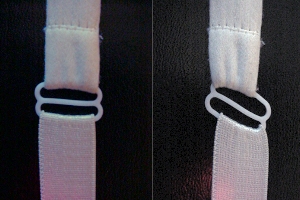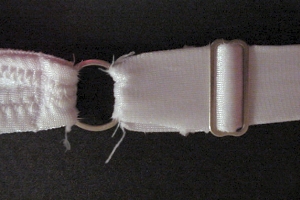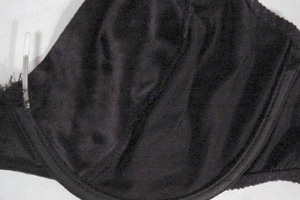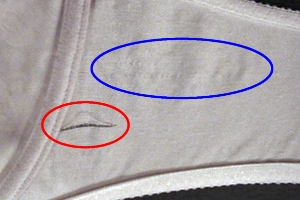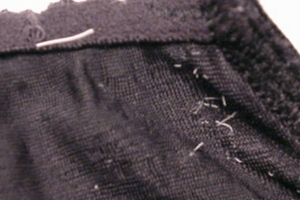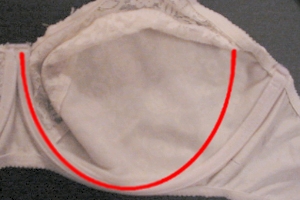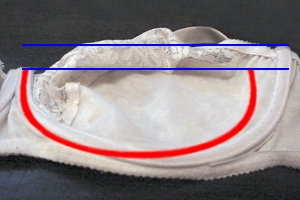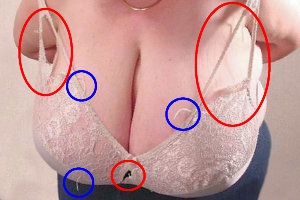BUYING A BRA | BRA FATIGUE | HOW TO FIX BRAS | MAKING BRAS FROM SCRATCH | STEF'S BRA FAQ | LINKS
|
BRA FATIGUE (Laundering and Big Boobs -- a bra's worst enemies!)
After about six months of regular wear, bras start to give out. After a year, you should retire them and get measured for new ones. Normal Aging Let's face it, some of us just cannot part with our favourite old bras. They are ratty, faded and don't fit right anymore but we keep wearing them anyway. After about six months of regular wear, bras start to give out. After a year, you should retire them and get measured for new ones. Here's why... Over time, the elasticity in cups and the band weaken and a lot of support is lost. Cups and band stretch and become loose so your boobs droop and bounce more. The more they bounce, the more they damage the straps and band. Plastic buckles, sliders, and rings on straps are originally soft and flexible but become brittle and break with repeated strain. Often they will slip on an angle and this distributes the same amount of pressure onto a smaller surface, causing the plastic to bow or bend. The more it bends, the more it slips and the pressure increases on a smaller area until it breaks. Average or even smaller sized breasts will cause this damage as easily as larger breasts if the straps are tight. On larger bras, metal parts are used instead of plastic ones since the heavier loads they much support tend to snap them more easily. But unlike their plastic counterparts, the metal pieces can cut at the fabric and the straps become frayed over time.
Accelerated Damage from Laundering If you've never had a washing machine rip the wires out of your bra or had it wrap around the agitator, then consider yourself lucky. Unlike other articles of clothing which are relatively bulky, bras are long and slim which make them more susceptible to damage:
When washing, each bra should have the hooks closed and then folded into a "bra bag" or mesh bag so this type of damage won't occur. The drier is not nearly as bad as the washer but the heat damages fibres, weakens stitching, and hardens plastics. The more often you machine wash and dry your garments, the quicker they age. It is recomended that you handwash bras and let them air dry to extend their life.
Accelerated Damage from Wearing Boobs... the reason that bras exist... are also the undoing of many a support garment. And the bigger the boobs, the quicker the garment fails. Large breasts put more pressure on the straps and cups. They also tend to bounce more than smaller breasts. Even with walking, a repeated hefty bounce stresses seams and stretches elastics.
Many women have warped underwires -- not from washing machine damage -- from simply wearing them! This does not happen instantly but with repeated wear. It is the result of wearing a bra is simply too small. When the width of the cup is less than the diameter of the breast, the flesh crammed into the cup makes the space wide enough by bending the wire. Not only does the breast push the ends of the underwire apart, it pushs and pulls the opposite ends. Imagine gripping the ends of a U-shaped wire in your hands. Now move your hands apart, pushing your left hand away from you and pulling your right hand towards you and hold that position for several hours. In addition to the cup being too small, sometimes the band is too tight so the band also pulls on the outer side of the wire and bends it. The wires are designed to flex and support but are not designed for this extra undo stress. These forces put an extreme amount of pressure on the vertex of the wire and often snap it in two -- but this is exactly what breasts do to bras. One lady I did a fitting for came in wearing a 40DD but needed a 40G. The wires in her bra were so bent I thought they had been warped by a washing machine but she said that she only handwashes her bras. After a year of wearing, her breasts had reshaped the wires from 7 inches wide to over 8 inches! She left her old 40DD bra with me so I decided to take some pictures to illustrate this type of bra fatique:
Even more devastating than large breasts are large nursing breasts. Regardless of whether the breasts are large or small, they are still considerably heavier than normal and the quick daily swelling put extreme pressure on seams. In fact, each nursing breast becomes at least one and a half pounds heavier than it was prepregnancy due to increased blood flow, enlarged glands, and milk production. The average difference in fullness or circumference between an emptied breast and one bulging with milk is 2 inches -- that's two full cup sizes! Last year I made a couple of custom nursing bras for a mother who had problems with her other bras wearing out very fast. Since nursing bras become soaked with milk, they have to be washed more frequently than fashion bras. Overwashing can be brutal on any type of bra but the breaking point comes when you add extremely heavy breasts that are simply too large for it. Her store-bought bras only lasted about eight weeks... the left underwire had snapped in each one, seams let go in multiple places, and hooks burst on the nursing flaps. The two worn out bras were size 40J (she needed larger but that was the biggest size they carried) and I measured her at a 42K! Update: This lady e-mailed me recently (and also sent a picture of her wonderful daughter :-). She was happy to report that the two custom bras which I made for her were holding up very well and she intends to continue wearing them until she weans her daughter at about 12 months.
When you add up all of this abuse, is it any wonder that our bras become so fatigued? When you get a new bra, remember to admire it for a moment and perhaps ask for its forgiveness for hardships it will indure for you over the next 6-12 months. |
Please Sign my Guestbook | View my Guestbook
